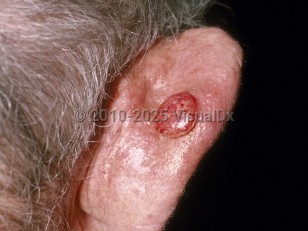Cutaneous squamous cell carcinoma - Anogenital in
See also in: Overview,Hair and Scalp,Nail and Distal DigitAlerts and Notices
Important News & Links
Synopsis

Almost one-third of patients with vulvar tumors present with locally advanced disease, usually resulting from late presentation due to older age, lack of access to medical care, or perceived embarrassment regarding tumor location. Late-stage tumors are more difficult to treat and may require radical surgical intervention.
The clinical presentation is variable. SCC often presents as a hyperkeratotic papule or nodule that may ulcerate, but it may also be smooth, plaque-like, exophytic, or papillomatous. Lesions are often red to skin colored. Secondary changes such as scale, crust, erosion, and ulceration may be present. The progression of lesions over time varies. Some enlarge slowly, while others progress rapidly to grow, infiltrate deeper tissue, and metastasize. Pain and tenderness can be present. Anal carcinomas may also present with rectal bleeding and a sensation of an object in the rectum.
The pathogenesis of SCC is multifactorial. It may evolve from intraepithelial neoplasia (including vulvar intraepithelial neoplasia or anal intraepithelial neoplasia) or arise de novo. TP53 gene mutations have been implicated. Any repetitive trauma or insult increases the risk of SCC. Additional risk factors for anogenital SCC include smoking, sexually transmitted infections, HIV infection, human papillomavirus (HPV) infection, poor genital hygiene, anogenital injury, lichen sclerosus, and erosive lichen planus.
Women who engage in receptive anal intercourse and women with immunocompromised states such as HIV should undergo regular anal Papanicolaou (Pap) screening tests.
Related topics: bowenoid papulosis, squamous cell carcinoma in situ
Codes
C44.92 – Squamous cell carcinoma of skin, unspecified
SNOMEDCT:
402815007 – Squamous cell carcinoma
Look For
Subscription Required
Diagnostic Pearls
Subscription Required
Differential Diagnosis & Pitfalls

Subscription Required
Best Tests
Subscription Required
Management Pearls
Subscription Required
Therapy
Subscription Required
Drug Reaction Data
Subscription Required
References
Subscription Required
Last Updated:04/09/2023
 Patient Information for Cutaneous squamous cell carcinoma - Anogenital in
Patient Information for Cutaneous squamous cell carcinoma - Anogenital in - Improve treatment compliance
- Reduce after-hours questions
- Increase patient engagement and satisfaction
- Written in clear, easy-to-understand language. No confusing jargon.
- Available in English and Spanish
- Print out or email directly to your patient


